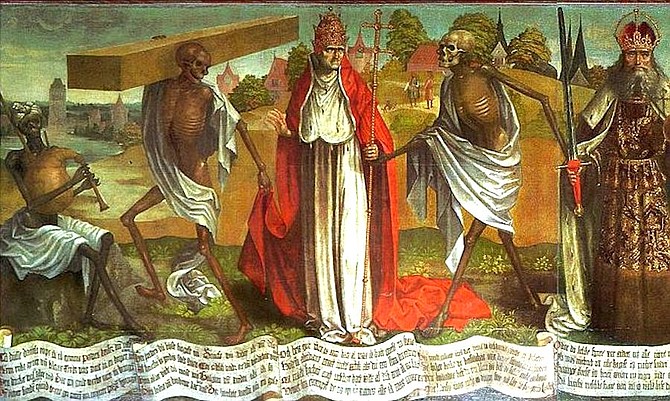 Facebook
Facebook
 X
X
 Instagram
Instagram
 TikTok
TikTok
 Youtube
Youtube

There’s Covid-19 and then there’s the Black Death. The height of the Black Death was between the years of 1347-1351. Estimates for the number of deaths in, during the Black Death, range to 200 million.
A culture of death was established as a result of the Black Death. The Danse Macabre was a visual representation of the immediacy of death. In the murals, death danced with the Pope, kings, merchants, knights, maidens, lords, serfs, children, and clerics. No one was spared, death functioned as the great equalizer. It still does.
There have been several musical settings of the Danse Macabre; the version by Camille Saint-Saëns is the most famous. Other composers such as Gustav Mahler, Franz Liszt, and Dimitri Shostakovich have created music based on the grim reaper.
My favorite setting is Songs and Dances of Death by Modest Mussorgsky. In keeping with the tradition, Mussorgsky sprinkles death across a variety of demographics.
The first song, Lullaby brings us the death of an infant. Death addresses the mother,
Following Lullaby is Serenade. A sick maiden lies awake thinking of life’s pleasures while death sings to her.
The third song follows a drunken peasant into the woods where he freezes to death, and then we come to the fourth song which is called The Fieldmarshal. Here, death is portrayed as a general presiding over a vast battlefield of the dead illuminated by moonlight. Death explains,
All four deaths were common not only in 19th Century Russia but in every country, including the United States. We can look to Walt Whitman’s A Dirge for Two Veterans for an American verse similar to the moon-lit procession of Mussorgsky’s Fieldmarshal.


There’s Covid-19 and then there’s the Black Death. The height of the Black Death was between the years of 1347-1351. Estimates for the number of deaths in, during the Black Death, range to 200 million.
A culture of death was established as a result of the Black Death. The Danse Macabre was a visual representation of the immediacy of death. In the murals, death danced with the Pope, kings, merchants, knights, maidens, lords, serfs, children, and clerics. No one was spared, death functioned as the great equalizer. It still does.
There have been several musical settings of the Danse Macabre; the version by Camille Saint-Saëns is the most famous. Other composers such as Gustav Mahler, Franz Liszt, and Dimitri Shostakovich have created music based on the grim reaper.
My favorite setting is Songs and Dances of Death by Modest Mussorgsky. In keeping with the tradition, Mussorgsky sprinkles death across a variety of demographics.
The first song, Lullaby brings us the death of an infant. Death addresses the mother,
Following Lullaby is Serenade. A sick maiden lies awake thinking of life’s pleasures while death sings to her.
The third song follows a drunken peasant into the woods where he freezes to death, and then we come to the fourth song which is called The Fieldmarshal. Here, death is portrayed as a general presiding over a vast battlefield of the dead illuminated by moonlight. Death explains,
All four deaths were common not only in 19th Century Russia but in every country, including the United States. We can look to Walt Whitman’s A Dirge for Two Veterans for an American verse similar to the moon-lit procession of Mussorgsky’s Fieldmarshal.